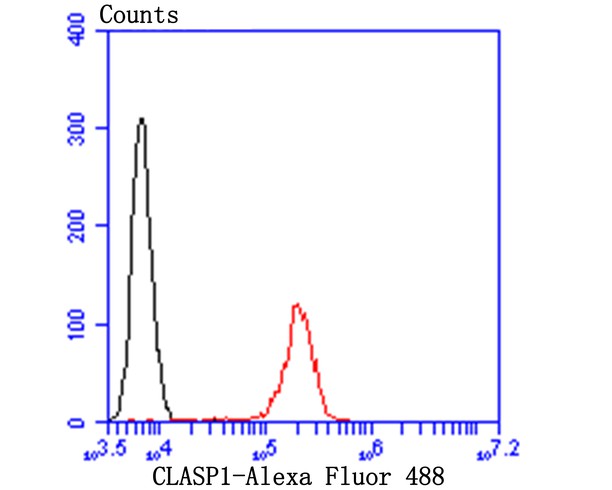CLASP1 Recombinant Rabbit Monoclonal Antibody [JE43-19]

cat.: ET7109-31
| Product Type: | Recombinant Rabbit monoclonal IgG, primary antibodies |
|---|---|
| Species reactivity: | Human, Mouse, Rat |
| Applications: | WB, IF-Cell, IF-Tissue, IHC-P, FC |
| Clonality: | Monoclonal |
| Clone number: | JE43-19 |
| Form: | Liquid |
| Storage condition: | Shipped at 4℃. Store at +4℃ short term (1-2 weeks). It is recommended to aliquot into single-use upon delivery. Store at -20℃ long term. |
| Storage buffer: | 1*TBS (pH7.4), 0.05% BSA, 40% Glycerol. Preservative: 0.05% Sodium Azide. |
| Concentration: | 1ug/ul |
| Purification: | Protein A affinity purified. |
| Molecular weight: | Predicted band size: 169 kDa |
| Isotype: | IgG |
| Immunogen: | Synthetic peptide within Human CLASP1 aa 1-50 / 1,538. |
| Positive control: | HepG2 cell lysate, Daudi cell lysate, SH-SY-5Y, SiHa, rat kidney tissue, human stomach tissue, human small intestine tissue, mouse colon tissue. |
| Subcellular location: | Cytoskeleton, Golgi apparatus. |
| Recommended Dilutions:
WB IF-Cell IF-Tissue IHC-P FC |
1:500-1:2,000 1:50-1:200 1:50-1:200 1:50-1:1,000 1:50-1:100 |
| Uniprot #: | SwissProt: Q7Z460 Human | Q80TV8 Mouse Entrez Gene: 304740 Rat |
| Alternative names: | 1700030C23Rik 5730583A19Rik B130045P17Rik CLAP1_HUMAN clasp1 CLIP associating protein 1 CLIP associating protein CLASP1 CLIP-associating protein 1 Cytoplasmic linker associated protein 1 Cytoplasmic linker-associated protein 1 DKFZp686D1968 DKFZp686H2039 FLJ33821 FLJ41222 hOrbit1 KIAA0622 MAST1 MGC131895 mKIAA0622 Multiple asters 1 Multiple asters homolog 1 Protein Orbit homolog 1 |
Images

|
Fig1:
Western blot analysis of CLASP1 on different lysates with Rabbit anti-CLASP1 antibody (ET7109-31) at 1/500 dilution. Lane 1: HepG2 cell lysate Lane 2: Daudi cell lysate Lysates/proteins at 10 µg/Lane. Predicted band size: 169 kDa Observed band size: 150 kDa Exposure time: 2 minutes; 6% SDS-PAGE gel. Proteins were transferred to a PVDF membrane and blocked with 5% NFDM/TBST for 1 hour at room temperature. The primary antibody (ET7109-31) at 1/500 dilution was used in 5% NFDM/TBST at room temperature for 2 hours. Goat Anti-Rabbit IgG - HRP Secondary Antibody (HA1001) at 1:200,000 dilution was used for 1 hour at room temperature. |

|
Fig2: ICC staining CLASP1 in SH-SY-5Y cells (green). Formalin fixed cells were permeabilized with 0.1% Triton X-100 in TBS for 10 minutes at room temperature and blocked with 1% Blocker BSA for 15 minutes at room temperature. Cells were probed with YTHDF1 polyclonal antibody at a dilution of 1:50 for 1 hour at room temperature, washed with PBS. Alexa Fluorc™ 488 Goat anti-Rabbit IgG was used as the secondary antibody at 1/100 dilution. The nuclear counter stain is DAPI (blue). |

|
Fig3: ICC staining CLASP1 in SiHa cells (green). Formalin fixed cells were permeabilized with 0.1% Triton X-100 in TBS for 10 minutes at room temperature and blocked with 1% Blocker BSA for 15 minutes at room temperature. Cells were probed with YTHDF1 polyclonal antibody at a dilution of 1:50 for 1 hour at room temperature, washed with PBS. Alexa Fluorc™ 488 Goat anti-Rabbit IgG was used as the secondary antibody at 1/100 dilution. The nuclear counter stain is DAPI (blue). |

|
Fig4: Immunohistochemical analysis of paraffin-embedded rat kidney tissue using anti-CLASP1 antibody. The section was pre-treated using heat mediated antigen retrieval with Tris-EDTA buffer (pH 8.0-8.4) for 20 minutes.The tissues were blocked in 5% BSA for 30 minutes at room temperature, washed with ddH2O and PBS, and then probed with the antibody (ET7109-31) at 1/50 dilution, for 30 minutes at room temperature and detected using an HRP conjugated compact polymer system. DAB was used as the chrogen. Counter stained with hematoxylin and mounted with DPX. |

|
Fig5:
Immunohistochemical analysis of paraffin-embedded human stomach tissue with Rabbit anti-CLASP1 antibody (ET7109-31) at 1/1,000 dilution. The section was pre-treated using heat mediated antigen retrieval with Tris-EDTA buffer (pH 9.0) for 20 minutes. The tissues were blocked in 1% BSA for 20 minutes at room temperature, washed with ddH2O and PBS, and then probed with the primary antibody (ET7109-31) at 1/1,000 dilution for 1 hour at room temperature. The detection was performed using an HRP conjugated compact polymer system. DAB was used as the chromogen. Tissues were counterstained with hematoxylin and mounted with DPX. |

|
Fig6:
Immunohistochemical analysis of paraffin-embedded human small intestine tissue with Rabbit anti-CLASP1 antibody (ET7109-31) at 1/1,000 dilution. The section was pre-treated using heat mediated antigen retrieval with Tris-EDTA buffer (pH 9.0) for 20 minutes. The tissues were blocked in 1% BSA for 20 minutes at room temperature, washed with ddH2O and PBS, and then probed with the primary antibody (ET7109-31) at 1/1,000 dilution for 1 hour at room temperature. The detection was performed using an HRP conjugated compact polymer system. DAB was used as the chromogen. Tissues were counterstained with hematoxylin and mounted with DPX. |

|
Fig7: Immunohistochemical analysis of paraffin-embedded mouse colon tissue using anti-CLASP1 antibody. The section was pre-treated using heat mediated antigen retrieval with Tris-EDTA buffer (pH 8.0-8.4) for 20 minutes.The tissues were blocked in 5% BSA for 30 minutes at room temperature, washed with ddH2O and PBS, and then probed with the antibody (ET7109-31) at 1/50 dilution, for 30 minutes at room temperature and detected using an HRP conjugated compact polymer system. DAB was used as the chrogen. Counter stained with hematoxylin and mounted with DPX. |

|
Fig8: Flow cytometric analysis of CLASP1 was done on SiHa cells. The cells were fixed, permeabilized and stained with YTHDF1 antibody at 1/100 dilution (red) compared with an unlabelled control (cells without incubation with primary antibody; black). After incubation of the primary antibody on room temperature for an hour, the cells was stained with a Alexa Fluor™ 488-conjugated goat anti-rabbit IgG Secondary antibody at 1/500 dilution for 30 minutes. |
Note: All products are “FOR RESEARCH USE ONLY AND ARE NOT INTENDED FOR DIAGNOSTIC OR THERAPEUTIC USE”.